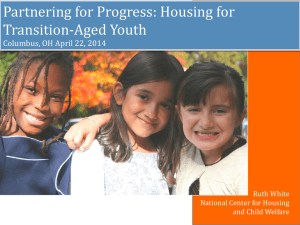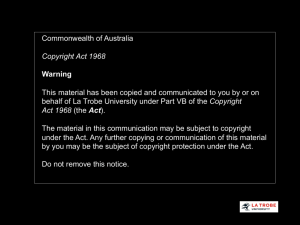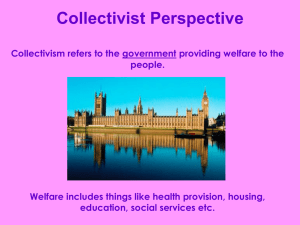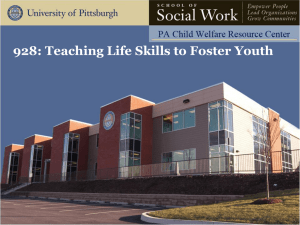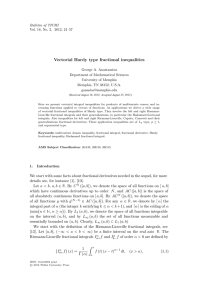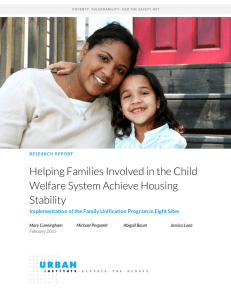PowerPoint - Supportive Housing Network of New York
advertisement
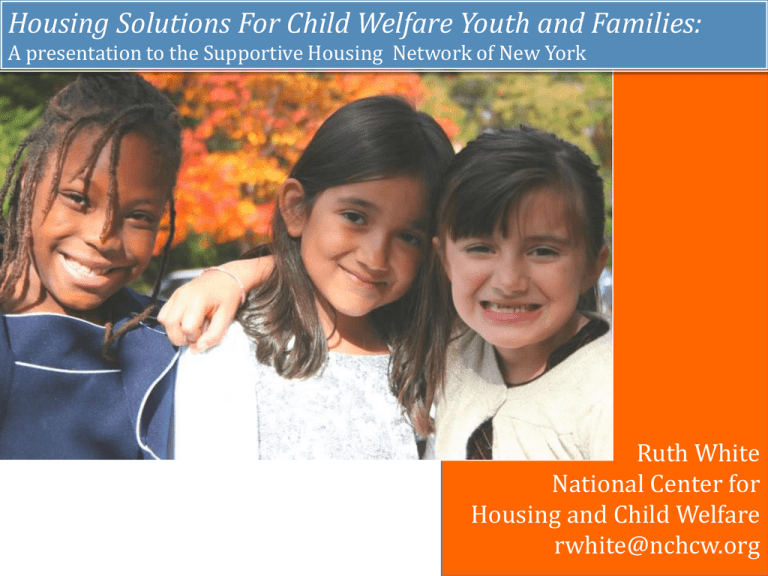
Housing Solutions For Child Welfare Youth and Families: A presentation to the Supportive Housing Network of New York Ruth White National Center for Housing and Child Welfare rwhite@nchcw.org The National Center for Housing and Child Welfare (NCHCW) 2 NCHCW links housing resources to child welfare agencies to improve family functioning, prevent family homelessness, safely reduce the need for out-of-home placement, and ensure that each young person who ages out foster care is able to access safe, decent, permanent housing. Housing Matters for Families 3 Housing affects families at each decision point in the child welfare continuum. Children from families with housing problems are: More likely to be investigated by CPS (Culhane et al, 2004) More likely to be placed in out-of-home care (Courtney et al, 2004) Longer stayers in foster care (Jones, 1998) Thirty percent of children in foster care (or about 126,000 kids) are separated from their parents because of housing problems (Doerre & Mihaly, 1996; Hagedorn, 1995; Thoma, 1998). Housing is Cost-Effective 4 A $15 million investment in FUP means that more than 3500 children will return home or avoid foster care for an annual savings of $74 million (or $56, 892 per family). (Harburger and White, 2004). It costs approximately $53,500 to serve a homeless young person on the street or in residential treatment but supportive housing for one young person costs only $5,300. (Van Leeuwen, 2004). 5 How can CW begin to address housing? Acknowledge the difficulty that the lack of housing tools poses to frontline cw staff. Consider the advantage that cw workers have over homeless shelter workers in preventing family and youth homelessness and train them accordingly. Use state child welfare funds to subsidize housing Participate in conversations governing the distribution of community housing resources. Partner with housers to provide housing tools to cw workers. Family Unification Program (FUP) •FUP is a housing program for families and youth in the child welfare system. At minimum, FUP provides Section 8 vouchers to child welfare families and youth aging out of care. •FUP is a collaboration between Public Housing Authorities and Public Child Welfare Agencies. •FUP is a program designed to strengthen and stabilize child welfare families. 7 What is the status of FUP funding? From 1992 through 2001, HUD awarded an average of 3,500 vouchers to FUP. In 2000, Sen. Bond added youth ages 18-22 who left foster care after age 16 as an eligible population for FUP. From 2002-2007, Congress provided funding but HUD opted not to fund FUP . In 2008-9, Sens. Murray and Bond directed HUD to spend $40 million on FUP or 5,083 FUP vouchers HUD awarded $15 million for just over 1,900 vouchers on June 2, 2011. FUP Partnership Model US Dept of Housing and Urban Devt. (HUD) Department of Children and Families (child Info and cooperation welfare) Funding for Sec. 8 vouchers Funding and referrals Family/Youth Housing assistance and case management Supportive Housing (IL Program) Issues voucher to youth Pays rent on time Landlord Local Public Housing Authority (PHA) Pays rent on time Supportive Housing for Families A Collaborative in Connecticut Funded by Department of Children and Families (DCF) Rental subsidies provided by Department of Social Services (DSS) Additional Collaborators: Department of Mental Health and Addiction Services (DMHAS) John D’Amelia Associates and local Housing Authorities Community, civic and faith-based organizations © The Connection, Inc. Supportive Housing for Families - The ConnecticutionApproach A 3-pronged strategy for long-term success in housing families who are homeless or at risk of becoming homeless referred by DCF: Intensive Case Management Services Flexible Funds Rental Subsidies for Families Section 8 or RAP Certificates What is the capacity of SHF? 11 Current capacity to serve 500 families Over 1,084 Families Housed Over 2,710 Children Housed 100% utilization of housing vouchers Success in identifying quality housing Success in landlord relationships Success in lease-up process State and Local Examples of Serving Child Welfare Families and Youth with Various and Creative Mix of Housing Funds 12 City of Las Vegas: setting local Section 8 priorities. The Housing Authority of the City of Las Vegas partnered with DSS and created a local waitlist preference for Housing Choice Vouchers. When a voucher becomes available, eligible foster youth through a referral from DSS, receives a voucher plus services. Colorado State: Using IDAs to support youth success The Colorado Family Unification Program (FUP) focuses on serving former foster care youth experiencing homelessness. In 2001, the Colorado Department of Human Services received 100 FUP vouchers. These Section 8 vouchers last for 18 months and are targeted specifically for youth ages 18–21 that leave foster care at age 16 or older with inadequate housing. Recently partnered with Mile High United Way to beef up case management. Through this partnership, youth have access to job training and IDAs New Jersey Example 15 Homeownership for Adopting Families NJHMFA's award-winning Home Ownership for Permanency Program provides home ownership mortgage loans to families that are newly adopting or making a permanent commitment through kinship legal guardianship for a child through the Department of Human Services, Division of Youth and Family Services, or a state-licensed adoption agency. NJHMFA also administered affordable housing for former foster youth. Florida Example: Using the HOME Program The Home Investment Partnership Program is a federal block grant that provides states with a flexible affordable housing funding stream. This money can be used to subsidize rent (best kept secret of HOME!) • Jeb Bush, when Governor, set aside 5% of HOME funds to subsidize rent for youth leaving foster care. New York City Example: Coupling Section 8 eligibility and the LIHTC •The LIHTC was established in 1986 in order to encourage the construction and rehabilitation of rental housing affordable to low income households. •NYCHA and ACS have been at the forefront of creating local priority codes for FUP eligible households and then using that status to leverage private dollars and developers in order to free up units for youth leaving foster care (my esteemed fellow panelists from ACS and the Lantern Group will elaborate on this . further). Some final thoughts on where to start Pay a visit to the states that have made strides, learn from their mistakes and achievements. States can use some homeless services and housing dollars for youth, but again, there are restrictions. Collaborations are the fastest, most efficient way to create a range of housing options. Urge child welfare agencies to contribute financially to housing costs for families but not that they will replace housers such as the PHA. Contact information Ruth White, MSSA Executive Director National Center for Housing and Child Welfare 6711 Queens Chapel Rd University Park, MD 20782 (301) 699-0151 rwhite@nchcw.org www.nchcw.org

